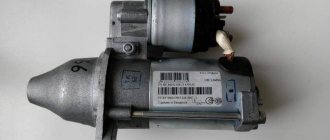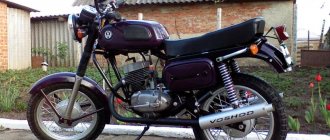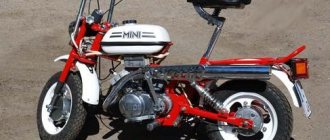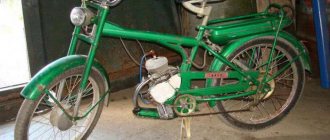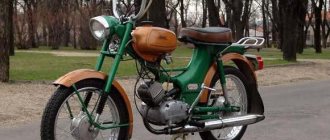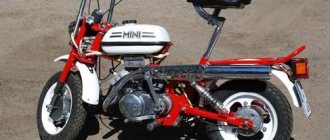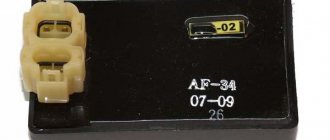Cars admin26.02.2020
Start.
Left for informational purposes, moped has been sold.
When riding a bicycle as a child, I always noticed that lucky guy riding a moped.
At that time, in my opinion, he looked somewhat admirable. It's hard to describe how I felt at that time. Of course, it didn’t become my first moped, but that’s what I wanted.
The first moped was a “kopeck piece” Mini motorcycle, then it seemed to me. There is even a photo preserved, but this is not what we are talking about. Acquisitions.
By chance, while talking with my robot partners, we started talking about a moped.
What is the value of the unnecessary Riga-13, its owner died. After standing in the garage for two years, they decided to sell it. I had no intention of buying it, but I wanted to take a look. The condition was not bad, I liked the fact that it was in its original condition. It started up easily, even that surprised me. Not a big video of the first engine start. “Red Star”, which in Latvian sounds like “Sarkana Zvaigzne”, is an enterprise that produced mopeds and motorcycles during the USSR period. Riga 13 - a moped or “hole”, as this model was called, was born at this plant. Then the sales of these mopeds went boom.
History Riga 13
This moped Riga replaced Riga 11. It was an easy form of transport that allowed you to quickly move over short distances. Riga 13 began to be produced in 1983.
The technical characteristics of the “hole” can be represented by the following features:
- the maximum speed that the moped could reach was 40 km/h;
- the engine installed on the moped was 1.3 liters;
- equipped with good light, a high-voltage transformer that eliminates problems with the ignition coil.
Moped Riga 13
Despite this, the “hole” often suffered from misfires, requiring modernization. Many owners of Riga, having read useful magazines published in those days, carried out their own tuning of this moped, achieving noticeable improvements in operation and design. Then either the improved models were sold at a high price, or the owner himself enjoyed driving.
ALL moped models RIGA
I didn’t see a single entry where all Riga moped models were listed. I thought: “if not me, then who?”
In 1958, the first moped “Spriditis” was released in Riga [1]. The experience was not entirely successful, and the plant designers went to the Czech Jawa plant for a detailed acquaintance with the production of small-capacity motorcycles. After this, in 1960, 10 copies of “Riga-1” were produced and sent for testing. In 50 days, the copies covered 10,000 km and the following year 5,000 pieces were produced, in 1962 - 27,000, and in 1965 - more than 90,000 pieces.
In 1965, the Riga-1 model was discontinued and was replaced by a new model of 1964 (TU No. 821-64) - Riga-3, equipped with a Sh-51 engine produced in Siauliai (the Sh-50 engine was installed in the first batches) . However, these engines turned out to be not as reliable as Czech ones and the popularity of mopeds waned. Externally, the Riga-3 moped was not very different from its predecessor, except for the modified shape of the brake drums and spokes, tank, cushion-type seat and frame with an extended tail section. "Riga-3" turned out to be almost 30% more powerful than "Riga-1", lighter by 2 kg and accelerated to 50 km/h.
From 1968 to 1974, Riga-4 was produced. This model was very similar to the Riga-3 and differed only in a small change in the hull lining and the introduction of new technical solutions to the design: the electrical circuit was changed (a high-voltage transformer was added), the design of the guards for the wheels and chains, the design of the gearbox gears, the trunk, installed new wheels of smaller diameter, and the speedometer was driven by the engine.
The light moped “Riga-5” was produced from 1966 to 1975 and was very different from the predecessors of the “Riga” series and from the “Gauja”, in which not a telescopic fork was used to dampen the front wheel, but compressed springs, allowing the fork to bend forward. The design has also been completely changed. The D-5 series engine without gears, started by pedals, made the moped easier to control, but the dynamics of the moped worsened.
"Riga-5" initially had a classic bicycle hub on the rear wheel, providing braking in the same way as a bicycle. But already in 1968, a modification appeared with shoe-type brakes on the rear wheel, and for some time both modifications were produced in parallel, after which shoe brakes completely replaced the bicycle-type rear hub. The frame was also strengthened (the corner bracket was lengthened), because the frames of previous models often cracked when driving on bad roads in the area adjacent to the steering column.
The Riga-7 moped began to be produced in 1969. By the end of 1971, it completely replaced the Riga-5 moped. Unlike the Riga-5, it was equipped with a D-6 engine, which made it possible to connect a headlight and rear marker lamp to it. The decorative protection of the drive chains has been removed. The design of the Riga-7 moped had a special rack installed to prevent frame breakage in cases of emergency braking. Plant workers H. Akermanis (electrician) and J. Bankovich (mechanic) proposed and tested, both on the stand and in practical driving conditions, a frame design with reinforced rear suspension without a rack.
Riga 13 has always needed modernization
Riga 13 or “hole” was simply ideal for trips to a dacha or apiary located not far from the city. Many users, precisely because of its ability to pass well on asphalt, concrete, and dirt roads, purchased this moped, the sale of which was put on stream.
Tank
Usually the 60 km round trip journey took about 4 hours. These are not bad indicators for those times, especially since Riga did not spend much. The tank was voluminous, but it was this that was often restyled. In particular, I didn’t like its color and facelessness.
Riga 13 moped tank before tuning
To add freshness and originality, today you can use the method invented in those days. The tank was painted in two colors. First, in some light color, with oven drying. After this, a second color was applied and dried in the same way in the oven. The end result was a beautiful design.
Mudguard
Particular attention was paid to the mudguard on the front wheel, which reliably protects the rider and the entire moped from dirt traveling in oncoming traffic. For the actual operation of a moped, this element is also very important today, especially in the autumn-spring season.
Hello everyone who likes to read posts. My name is Roman, I'm 14 years old. Today I am posting my post. Let's start! It all started with the fact that Riga 13 was rusty and no one needed, at first I thought it over carefully and in the end decided to fix this pile of scrap metal. I went to the city and bought a new cylinder, tire, piston for it, well, all this and other little things it was not cheap for it. When I installed new spare parts for the moped, I had to do a break-in, during this so-called break-in it worked poorly, and then I found out that I had to set the ignition and correctly, precisely, and not anyhow. I asked an old man on my street , who understood how to do it and he showed me, and then taught me a little to correct it, in short, so that it wouldn’t go astray. Well, in short, after a long period of brain strain, yes, yes, that’s right, it started to work normally, but it had its drawbacks: when driving fast, it choked and could even stall, warming it up was even more fun, I had to roll it all over the street back and forth like a king, so that it finally growled, and then it started up and they could already rush along the roads! I didn’t drive far on the rig because it could stall. There was an unpleasant drawback for my legs: hot oil dripped from the cylinder and shot like a bullet into my leg, but this could only be tolerated for only a short time, otherwise the oil would damage my legs They had already been cooked into pancakes for a long time, after a while I corrected the cause of the oil leak. Well, then I enjoyed riding on the rig, going somewhere and having my hands clean, this almost never happened, because after some distance I had to change the wet spark plug for a dry one. But then this reason was corrected; my father helped me with this. It all started interesting, I cleaned the moped of the old paint, painted it and made a seat that could fall apart, put a different throttle handle and lubricated it so that it worked perfectly. But then that sad day came that I did not expect, when I was driving from a gas station along the road, the piston of the moped suddenly jammed and it stalled, and I quickly pulled over to the side of the road, I was sad that my rig broke, lifting the back of the moped where the wheel got stuck, I dragged it home. Thinking at home that it was no longer worth spending money on it for the reason that it had a lot of broken things, I sold it for scrap and received quite a bit of money for it. I’m not dreaming about the next moped or scooter yet, because the rights to these mopeds and scooters may be introduced. This is such a sad story. PS IT'S A PITY SUCH A COOL MOPED IT WAS FUN TO RIDE ON!!! I hope to buy myself a motorcycle when I'm 16!!!
Improved performance today
The technical characteristics of the moped can also be improved. For example, to increase rigidity in the front fork. After the modernization, torsional rigidity will be significantly improved and handling will improve several times. As a result, after the technical characteristics are improved, Riga will be driven as if on rails. If anyone is interested in selling an old “hole” or simply improving it, the instructions are most welcome.
Tuning option Riga 13
The technical features and improvements don't stop there. The engine, which the manual calls one of the most important components with which the “hole” is endowed, can also be restyled.
Where to begin
First you need to disassemble the motor using various brass and duralumin shafts. In this case, I would like to advise not to use steel or wooden tools.
Next, as recommended in the modification instructions, the bushings are checked. The spool bushing must be changed. The crankshaft is reassembled - most craftsmen recommend aligning it.
Then comes the installation of the CPG, oil seal and other parts. Particular attention is paid to the cuff, which on factory models has a hole just for the sake of beauty.
The clutch is also being rebuilt, a video of the process can be viewed separately.
Clutch on a moped Riga 13
Assembly Tips
Finally, installation of electronic ignition and the first start of the improved engine. You can install a B300 coil, after which the ignition will start working like a clock.
And, of course, equipping the moped with a backpack-trunk. After this, the “hole” will turn into a full-fledged mode of transport, which can be used to transport cargo to the dacha and back.
It is advisable, before carrying out independent tuning of Riga 13, to study the video or, in extreme cases, photo materials. Videos and photos will give a practical understanding of the process.
5mv.ru
Light moped "Riga-13": type, technical characteristics and operating features
The light moped "Riga-13" is produced to replace the model "Riga-11". Created for. operation as a single person on roads with different surfaces, in temperate climates.
The Riga-13 moped has improved performance compared to the Riga-11 model. The possibility of a lean combustible mixture has been eliminated by placing the fuel tank in the front part of the moped, the capacity of the fuel tank has been increased, the overtaking mechanism of the rear brake has been strengthened, the weight has been reduced by 2 kg, and the driver's position has been improved due to a lower position of the saddle. Has a trunk for transporting cargo weighing up to 15 kg.
Maximum speed, km/h 40
Control fuel consumption, l/km 2.0/100
Weight (dry), kg 42
Engine type D-8, single-cylinder, two-stroke (TU 37.004.176-81)
Engine displacement, cm 3 45.4
Maximum power, kW 0.96 (1.3 hp)
Carburetor K-34 B
Magneto ignition system
Double-disc clutch, semi-dry
Telescopic front fork with spring shock absorbers
Moped Riga 13 - a detailed review of the Soviet scooter
Serial production of Riga mopeds began 59 years ago. It was 1958 then. The first moped was the Riga-1 model. The production of this motorcycle equipment completely ended in 1998. As for the Riga 7 moped, its mass production began in 1969. All models were equipped with single-cylinder gasoline engines of varying power. These were reliable single and two speed vehicles. By the way, the working volume of these engines reached 50 cm³. The maximum speed of the latest models of the Riga 13 moped was 60 km/h.
Features of the moped
The release of Riga 7 mopeds was carried out together with the Riga-5 model, which at that time had not yet been withdrawn from mass production. However, it was completely discontinued in 1971. A certain notability of the Riga 7 moped was the D-6 engine, which had enough power for long trips, for the headlight, and also for the brake light. Unlike previous models, this one came with interchangeable wheels, a chrome muffler and a toolbox.
Product Specifications:
- Length – 186 cm.
- Width – 65 cm.
- Height – 105 cm.
- Tubular frame.
- Engine power is 1.2 horsepower.
- Spring shock absorbers.
- Telescopic front fork.
- Gasoline consumption per 100 km is no more than two liters.
- The maximum speed is 40 km/h.
Technical and operational characteristics of the moped Riga 11
The single-speed model Riga 11 replaced the Riga-7. It was given a more stylish appearance and equipped with powerful wheels. The engine remained the same - “D-6”. However, the model turned out to be quite heavy, and the frame was not entirely strong. In addition, the original fuel tank caused some inconvenience when driving uphill. If there was little gasoline left in it, then it did not enter the combustion chamber.
- Length – 197 cm.
- Width – 75 cm.
- Height – 150 cm.
- Spring shock absorbers.
- Telescopic front fork.
- The maximum speed is 40 km/h.
Moped Riga 12
The two-speed model is equipped with a Sh-57 engine, which contains bicycle-type pedals. They help the owner of a Riga 12 moped drive up a steep mountain. The model was equipped with fuel tanks of different shapes. This moped differed from the Riga-16 in having a shorter seat and a smaller trunk.
Technical characteristics of the Riga 12 model:
- Length – 197 cm.
- Width – 74 cm.
- Height – 116 cm.
- The power of the single-cylinder engine is 2.2 horsepower. Working volume – 49.8 cm³.
- More modern, improved steering wheel.
- The maximum speed is 50 km/h.
- Weight – 75 kg.
Technical characteristics and features of the moped Riga 13
After the appearance of the lightweight Riga 13 model, its main drawback immediately became apparent: the ignition was constantly interrupted. This was the biggest problem because the engine never started right away, so I had to ride the moped downhill for a long time with the gear in gear. In addition, the engine often turned off when idling. Manufacturers have partially eliminated this problem.
Technical characteristics of moped Riga 13:
- The power of a single-cylinder two-stroke engine is 1.3 horsepower. Working volume – 45.4 cm³.
- Cooling is air.
- The maximum speed is 40 km/h.
- Gasoline consumption per 100 km is 2 liters.
- Magneto ignition.
- The clutch is double-disc.
- The front fork is telescopic.
- Shock absorbers are spring.
Many Soviet teenagers dreamed of owning the Riga 13 model. It was this moped that became the most successful and reliable development of Riga engineers. Since the lubrication of the rubbing parts of the engines of mopeds of all Riga models was not systematic, motor oil was added to gasoline in a certain proportion, and this mixture lubricated the rubbing parts. Without lubrication, the engine fails instantly.
A distinctive feature of this model was the high-quality bright light of the headlights. The problems associated with the ignition coil were eliminated using a new high voltage transformer. As for engine malfunctions, the cause was the material from which the breaker hammers were made. They wore out quickly and did not reach the magneto cam. This was the reason for the failure to start the engine.

